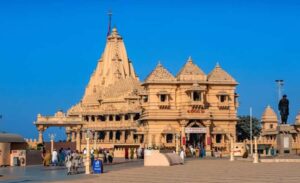History of Kedarnath Temple
Kedarnath Dham, nestled in the heart of the Himalayas, is one of the holiest and most revered pilgrimage sites for Hindus in India. Located in the Rudraprayag district of Uttarakhand, this sacred temple is dedicated to Lord Shiva and holds immense significance in Hindu mythology, history, and the hearts of millions of devotees who visit it annually. In this article, we will delve into the multifaceted aspects of Kedarnath Dham, exploring its significance, history, and the rich tapestry of mythology and legends that surround it.

Significance of Kedarnath Dham
Abode of Lord Shiva: Kedarnath is often referred to as the “Abode of Lord Shiva.” It is believed to be one of the twelve Jyotirlingas, which are the holiest shrines dedicated to Lord Shiva. As a Jyotirlinga, Kedarnath represents the radiant form of Lord Shiva and holds immense spiritual significance for devotees.
Spiritual Pilgrimage: Kedarnath Dham is an integral part of the Char Dham Yatra, a pilgrimage circuit that also includes Badrinath, Yamunotri, and Gangotri. Completing this pilgrimage is believed to cleanse the soul and lead to spiritual salvation.
Natural Beauty: Beyond its spiritual importance, Kedarnath is renowned for its breathtaking natural beauty. Surrounded by snow-capped peaks, lush green valleys, and pristine rivers, the region offers a serene environment that enhances the spiritual experience of pilgrims.
History of Kedarnath Dham
The history of Kedarnath Dham is intertwined with its religious significance and the cultural development of the region.
Ancient Origins: Adi Shankaracharya, the eminent philosopher and spiritual leader, left an indelible mark on Kedarnath’s history. Recognizing the sanctity of the region, he embarked on a pilgrimage to Kedarnath, where he meditated and rekindled its spiritual essence. His devotion to Lord Shiva prompted him to renovate and reestablish the Kedarnath temple, a gesture that solidified its status as one of the twelve Jyotirlingas. Adi Shankaracharya’s profound influence continues to inspire pilgrims and seekers who visit Kedarnath in pursuit of spiritual awakening and divine blessings.
Renovations and Rebuilding: Over the centuries, the temple faced natural calamities and destruction, particularly due to avalanches and earthquakes. Despite these challenges, it was rebuilt and renovated multiple times by various rulers and devotees.
Modern Reconstruction: In 2013, a devastating flash flood and landslides in the region caused significant damage to the temple and surrounding infrastructure. The government of Uttarakhand and various organizations undertook a massive reconstruction effort to restore Kedarnath Dham to its former glory.
Mythology and Legends of Kedarnath
The mythology and legends associated with Kedarnath Dham are deeply rooted in Hindu religious texts and folklore.
Mahabharata Connection: According to the Mahabharata, the Pandava brothers, on their quest for salvation, sought the blessings of Lord Shiva. Kedarnath is believed to be the place where they encountered Lord Shiva in the form of a bull, hiding from them. When they tried to catch him, the bull submerged into the ground, leaving behind its hump, which is worshipped at Kedarnath.
Goddess Parvati’s Devotion: Another legend speaks of Goddess Parvati performing severe penance at Kedarnath to win Lord Shiva’s heart and marry him. Impressed by her devotion, Lord Shiva accepted her as his consort, and the temple symbolizes their eternal union.
Bhima’s Penance: It is also believed that Bhima, one of the Pandava brothers, built a massive stone lingam at Kedarnath to seek forgiveness for the killings during the Kurukshetra war.
The Eternal Flame: Inside the temple, there is a sacred flame that is believed to be the eternal form of Lord Shiva. This flame has been burning continuously for centuries and is considered a divine manifestation of the deity’s presence.
Yogic Significance: Kedarnath is regarded as a place where Lord Shiva imparted the knowledge of yoga to the sages, making it a sacred site for yogic practice and spiritual enlightenment.
Under Snow for 400 Years
For four centuries, the sacred Kedarnath shrine lay hidden beneath a blanket of snow and ice, shrouded in the icy embrace of the Himalayas. During this extended period of isolation, it remained untouched by human hands, its significance and sanctity enduring through the ages. The long winter’s solitude only added to the mystique and reverence that surrounds this holy abode of Lord Shiva. Emerging from its frozen slumber, Kedarnath continues to draw pilgrims and seekers, a testament to its enduring spiritual allure.
Also Reads On:








